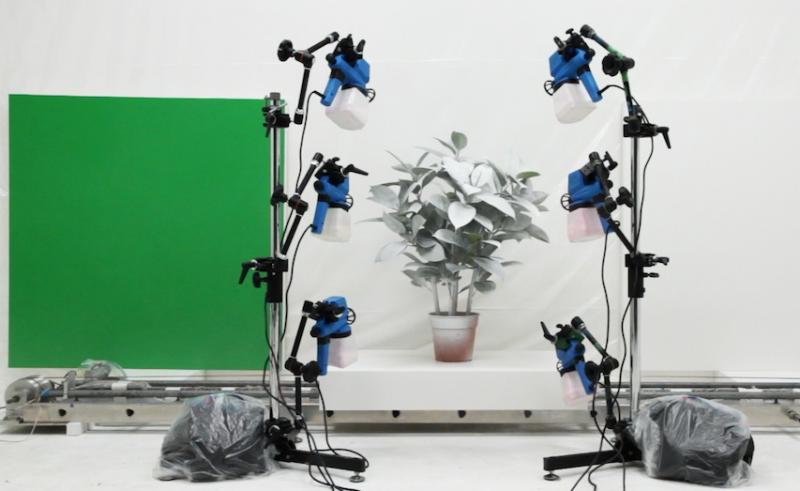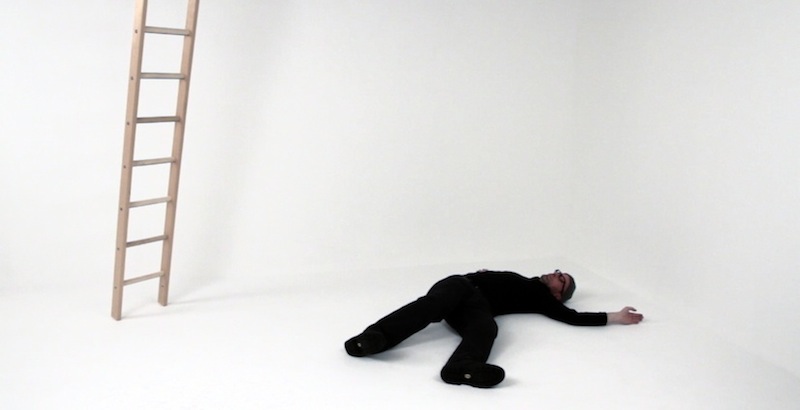John Wood and Paul Harrison, Carroll/Fletcher | reviews, news & interviews
John Wood and Paul Harrison, Carroll/Fletcher
John Wood and Paul Harrison, Carroll/Fletcher
The Laurel and Hardy of the art world venture from comedy to failed utopian dreams

Described by the Tate as the Laurel and Hardy of the art world, John Wood and Paul Harrison are best known for appearing in superbly timed, comic videos using their own bodies to explore spatial relations. Projected over the concrete stairwell of the Carroll/Fletcher gallery 100 Falls (pictured below right) is excruciating to watch. A black-clad figure in a white room disappears from view up a wooden ladder.
Semi Automatic Painting Machine (main picture) is a comic take on colour co-ordination, stylish living and camouflage. White lampshades are spray-painted red, yellow and green, so are balloons and a strip of white bunting. A rubber plant is sprayed white to match the wall, then green to match a coloured backdrop; a white door leaning against a white wall is sprayed red, but when it falls forward, it reveals a blue rectangle hidden behind. The jokes are all visual, so they don’t translate well into words, but the experience is utterly beguiling.
 For comedy to work it has to appear effortless, so a great deal of preparation goes into the making of each video. This often involves building simple but precise sets and some of the skills needed to construct the perfect scene are celebrated in a tongue-in-cheek installation about tools, drawing equipment and other useful items. Two propelling pencils share a singled lead; another pencil has been sharpened right down to the rubber; a length of string is measured against a ruler; blue tape is crumpled into a sticky ball and, mounted on a turntable, a globe revolves at 33 rpm. A garden bench lies on its back; attached to it, a bronze plaque reads: “Bench for Looking Up”. The humour is dry and the jokes visual; vision is refreshed and the familiar made strange by altering perceptions.
For comedy to work it has to appear effortless, so a great deal of preparation goes into the making of each video. This often involves building simple but precise sets and some of the skills needed to construct the perfect scene are celebrated in a tongue-in-cheek installation about tools, drawing equipment and other useful items. Two propelling pencils share a singled lead; another pencil has been sharpened right down to the rubber; a length of string is measured against a ruler; blue tape is crumpled into a sticky ball and, mounted on a turntable, a globe revolves at 33 rpm. A garden bench lies on its back; attached to it, a bronze plaque reads: “Bench for Looking Up”. The humour is dry and the jokes visual; vision is refreshed and the familiar made strange by altering perceptions.
Immaculately crafted from plywood, A Film About a City (pictured below) is like an architect’s model for a new town. One building has an arcade made from protractors, but most are rectangular blocks differentiated by unexpected details. One block has mirrored walls that reflect the buildings around it; the church, on the other hand, is completely surrounded by mirrors. One building is jacked up at an angle, while a whole neighbourhood cluster is completely covered in grass.
 The cars in the multi-storey car park are arranged according to colour – black, blue, green, red and white on respective floors. Peopling the place are identical white figures; one stands alone in a large square; two explore a Richard Serra-like sculpture; two others stand precariously on a high ledge and several stroll along a tree-lined avenue while, elsewhere in town, a crowd gazes out from a flat roof.
The cars in the multi-storey car park are arranged according to colour – black, blue, green, red and white on respective floors. Peopling the place are identical white figures; one stands alone in a large square; two explore a Richard Serra-like sculpture; two others stand precariously on a high ledge and several stroll along a tree-lined avenue while, elsewhere in town, a crowd gazes out from a flat roof.
This installation may represent someone’s idea of utopia, but housed downstairs is a series of models depicting failed dreams and abandoned projects. A patch of scruffy grass bears the marks of a dismantled funfair; an unfinished monorail goes nowhere and a rejected building project slowly rots and crumbles. Meanwhile, on video, a car rolls inexorably down to a watery grave at the bottom of a lake, while those left in the car park are blown up one by one.
The videos which made the artists famous were filmed in an all-white studio environment in which they appear dressed in black. Like 100 Falls, each absurdist event is a dynamic exploration of cause and effect in which the artists are simply generic figures – bodies in space acted on by gravity. Colour and all references to the outside world are excluded from the equation.
The work in this delightful exhibition opens the flood gates to the world outside. Narrative comes seeping in; colour, style, taste, politics, aspiration, planning, individual and collective dreaming and ambition all put in an appearance, whether literally or metaphorically. Time has lengthened from seconds into decades and the focus has widened from a momentary encounter in a studio to a discarded project in a landscape, or a vision of things to come.
These are exciting times in the world of John Wood and Paul Harrison. Long may their absurdist explorations and precisely honed humour continue to develop and flower.
Overleaf: Watch John Wood and Paul Harrison discuss their work
Explore topics
Share this article
more Visual arts
 Fantastic Machine review - photography's story from one camera to 45 billion
Love it or hate it, the photographic image has ensnared us all
Fantastic Machine review - photography's story from one camera to 45 billion
Love it or hate it, the photographic image has ensnared us all
 Yinka Shonibare: Suspended States, Serpentine Gallery review - pure delight
Weighty subject matter treated with the lightest of touch
Yinka Shonibare: Suspended States, Serpentine Gallery review - pure delight
Weighty subject matter treated with the lightest of touch
 Jane Harris: Ellipse, Frac Nouvelle-Aquitaine MÉCA, Bordeaux review - ovals to the fore
Persistence and conviction in the works of the late English painter
Jane Harris: Ellipse, Frac Nouvelle-Aquitaine MÉCA, Bordeaux review - ovals to the fore
Persistence and conviction in the works of the late English painter
 Sargent and Fashion, Tate Britain review - portraiture as a performance
London’s elite posing dressed up to the nines
Sargent and Fashion, Tate Britain review - portraiture as a performance
London’s elite posing dressed up to the nines
 Zineb Sedira: Dreams Have No Titles, Whitechapel Gallery review - a disorientating mix of fact and fiction
An exhibition that begs the question 'What and where is home?'
Zineb Sedira: Dreams Have No Titles, Whitechapel Gallery review - a disorientating mix of fact and fiction
An exhibition that begs the question 'What and where is home?'
 Yoko Ono: Music of the Mind, Tate Modern review - a fitting celebration of the early years
Acknowledgement as a major avant garde artist comes at 90
Yoko Ono: Music of the Mind, Tate Modern review - a fitting celebration of the early years
Acknowledgement as a major avant garde artist comes at 90
 Unravel: The Power and Politics of Textiles in Art, Barbican review - the fabric of dissent
An ambitious exploration of a neglected medium
Unravel: The Power and Politics of Textiles in Art, Barbican review - the fabric of dissent
An ambitious exploration of a neglected medium
 When Forms Come Alive, Hayward Gallery review - how to reduce good art to family fun
Seriously good sculptures presented as little more than playthings or jokes
When Forms Come Alive, Hayward Gallery review - how to reduce good art to family fun
Seriously good sculptures presented as little more than playthings or jokes
 Entangled Pasts 1768-now, Royal Academy review - an institution exploring its racist past
After a long, slow journey from invisibility to agency, black people finally get a look in
Entangled Pasts 1768-now, Royal Academy review - an institution exploring its racist past
After a long, slow journey from invisibility to agency, black people finally get a look in
 Barbara Kruger, Serpentine Gallery review - clever, funny and chilling installations
Exploring the lies, deceptions and hyperbole used to cajole, bully and manipulate us
Barbara Kruger, Serpentine Gallery review - clever, funny and chilling installations
Exploring the lies, deceptions and hyperbole used to cajole, bully and manipulate us
 Richard Dorment: Warhol After Warhol review - beyond criticism
A venerable art critic reflects on the darkest hearts of our aesthetic market
Richard Dorment: Warhol After Warhol review - beyond criticism
A venerable art critic reflects on the darkest hearts of our aesthetic market
 Dineo Seshee Raisibe Bopape: (ka) pheko ye / the dream to come, Kiasma, Helsinki review - psychic archaeology
The South African artist evokes the Finnish landscape in a multisensory installation
Dineo Seshee Raisibe Bopape: (ka) pheko ye / the dream to come, Kiasma, Helsinki review - psychic archaeology
The South African artist evokes the Finnish landscape in a multisensory installation

Add comment